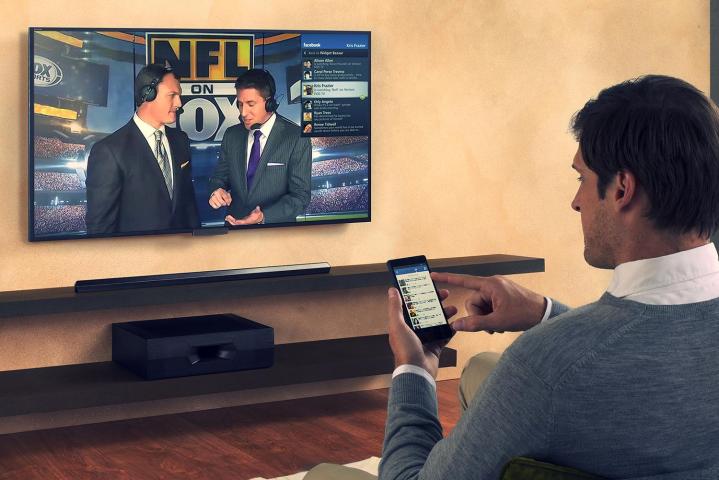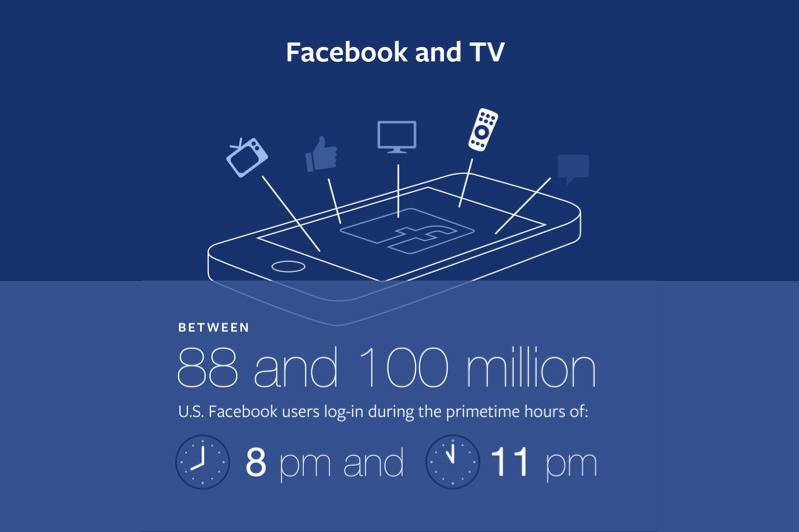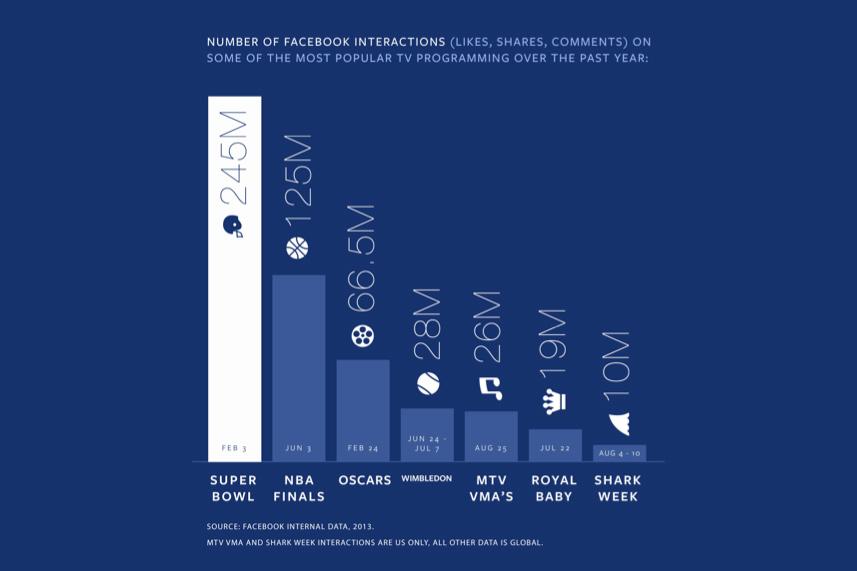
Earlier this week Facebook announced two new tools designed to help media companies integrate Facebook activity and conversations into live broadcasts. The idea is that broadcasters could display real-time stats about how often keywords or topics are being mentioned on Facebook or even quickly select messages to be displayed or read on-air, essentially enabling broadcast programming to engage in interactive “conversations” with potentially millions of members of their audience who are also logged into Facebook.
In some ways, the new tools are Facebook’s way of trying to catch up to Twitter, which to date has dominated the intersection of social media and traditional broadcasting. But, in other ways, Facebook is looking to redefine and expand how we consume and interact with traditional broadcast programming – and that could be crucial to mass media given how many people are now watching television with a tablet or smartphone in their hand.
Can Facebook bring something valuable to broadcast media, or has Twitter already locked down the “second screen”?
What’s Facebook offering?
Facebook’s latest play to real-time media companies has two parts: Public Feed and Keyword Insights.
The Public Feed is the ability to search everything everyone on Facebook shares in public for a specific word (like “Syria” or “Obama”) and get back a continuous, near-real-time stream of every public post with that term, along with who said it and when. Because the posts are linked to particular Facebook users, it’s simple for Public Feed customers to pull up any information Facebook considers “public” about any user – things like name, gender, profile images, and friend count, and (most likely) key demographic information like age and location.
Keyword Insights scans all Facebook content – even the private stuff! – to compile aggregate information about a specific term over a specific period of time in the last twelve days. However, Keyword Insights does not associate results with individual Facebook users or provide access to the posted content. So, a media company could determine how many people have entered the hashtag #samcro (often used by Sons of Anarchy fans) in the last 24 hours, but they won’t get a the actual posts to know whether they’re good, bad, indifferent, or just typos. But if Facebook doesn’t give names with Keyword Insights, it does provide summaries based on age, gender, and location (down to cities), so media companies can know how many of those people mentioning Sons of Anarchy are (say) males between 18 and 24 and living in California – even if that hashtag only appeared in a private post to themselves.
Who can use Public Feed and Keyword Insights? Right now, it’s just a few selected partners, including (but not limited to) CNN, the UK/Irish BSkyB satellite television service, Buzzfeed, Slate, and NBC’s Today show, along with a handful of behind-the-scenes companies that offer social platforms and analysis. Facebook is working to add other partners; soon, you can expect any major media outlet or advertiser to have access to these capabilities, either directly from Facebook or through a third party.
How does this get Facebook on TV?
Folks familiar with some of Facebook’s inner workings may have noticed that Public Feed and Keyword Insights are similar to parts of Facebook’s Graph API, which (among other things) lets Facebook developers pull data like status updates and likes, search by keyword, and look at the social connections between results.
“The Graph API has been around for a while, but reliability has been a problem,” noted Damon Cortesi, co-founder and CTO of social metrics firm SimplyMeasured. “Facebook iterates so quickly.”
“I’d personally like to see social add value beyond ork! ork! ork! trained-seal contests to pump up mentions”
“Twitter is one of the first networks we started pulling data from because it was so easy,” noted Cortesi. “You tell it what keywords you want to track, and you receive data in real time.”
To be fair, Twitter doesn’t deliver real-time data directly to mainstream media: instead, it works with two companies (Datasift and GNIP), who in turn provide access to the “firehose” of real-time Twitter data. However, some of the reasons Twitter has been so successful at integrating with television and traditional media is both the narrow, short-message focus of the service (there’s not much to do with Twitter other than tweet!) and the dependability of those real-time services. Programming like X Factor, Breaking Bad, and Discovery’s Shark Week can rely on getting real-time data from Twitter to augment their programming. With Facebook, that proposition has been chancier: nobody wants to go on the air and say “Welp, we were going to take some questions from Facebook, but our systems don’t seem to be working. Sorry.”
How does this make better TV?
The real-time nature of social networking means social content is most relevant to live programming like news, sports, and some reality shows rather than (say) scripted dramas where time-shifting and DVRs tend to spread audiences over a longer period of time. Few people want to catch up on Showtime’s Dexter and see a months-old (or years-old!) tweet scrolling across the bottom of the screen.
Speaking on background, representatives of both CNN and BSkyB indicated they’re looking carefully at how to best integrate social content with their programming. BSkyB’s initial focus seems to be on bringing viewer feedback and opinions into sports programming, while CNN is looking at approaches to daily news.
“We have to make good television,” said one CNN representative who did not want to be identified. “A lot of social integration is based on voting. That works great for some formats, but not others. I’d personally like to see social add value beyond ork! ork! ork! trained-seal contests to pump up mentions or likes so the audience can get a treat. Ultimately, I think that’s demeaning.”

That idea of adding value is the crux of the matter; any Facebook or Twitter user knows that the majority of posts they see are of dubious value or usefulness. So, what’s in this for TV?
“Social media is like holding a mirror up to your audience,” said Sam Decker, CEO of Mass Relevance, one of the first companies to be working with Facebook’s new features. “When viewers see themselves recognized and reflected, they’re immediately interested and more likely to participate. It’s like going to a football game and seeing yourself on the Jumbotron: people immediately respond.”
If the Jumbotron at football games is the benchmark for audience engagement, don’t expect Facebook to be improving your TV experience anytime soon. But if the integration can manage to play to social media’s strengths – surfacing news, information, or people who might otherwise have been missed – that made be real added value for broadcasters and the audience.
“It’s a win for viewers because social content can provide depth and information that wouldn’t have been included in programming,” said Decker.
Baby steps
Social media’s impact on mainstream media like television is still limited, but recent surveys find 87 percent of TV watchers have some sort of second screen (whether a PC or mobile device) and 62 percent of mobile Web users use their mobile devices while watching TV.
Mainstream media is increasingly desperate to remain front and center in consumers’ lives. But they’ve got to be smart about it, and that might mean going slow.
“We are training an audience to engage and this will take time,” wrote never.no CCO Kelly Moulton in the company blog. “Think 10years for mass response and appeal (if we get the formats right) … We need to be patient and think in terms of seasons, years, not special events and one-off novelty exercises.”
So, yes: Facebook wants to be a bigger part of TV. But we haven’t even seen the pilot.
[Image via Shutterstock / GoodLuz]




